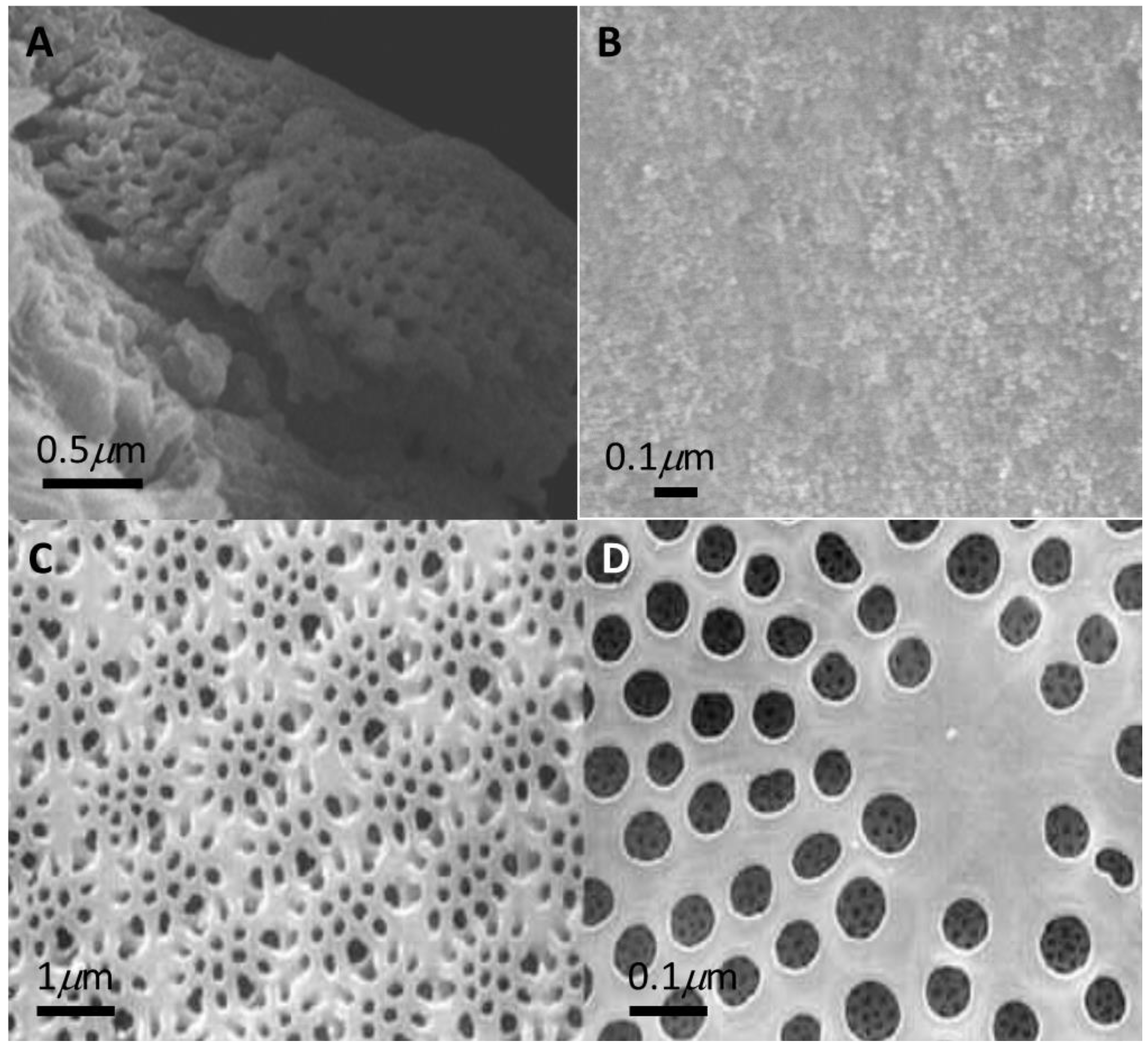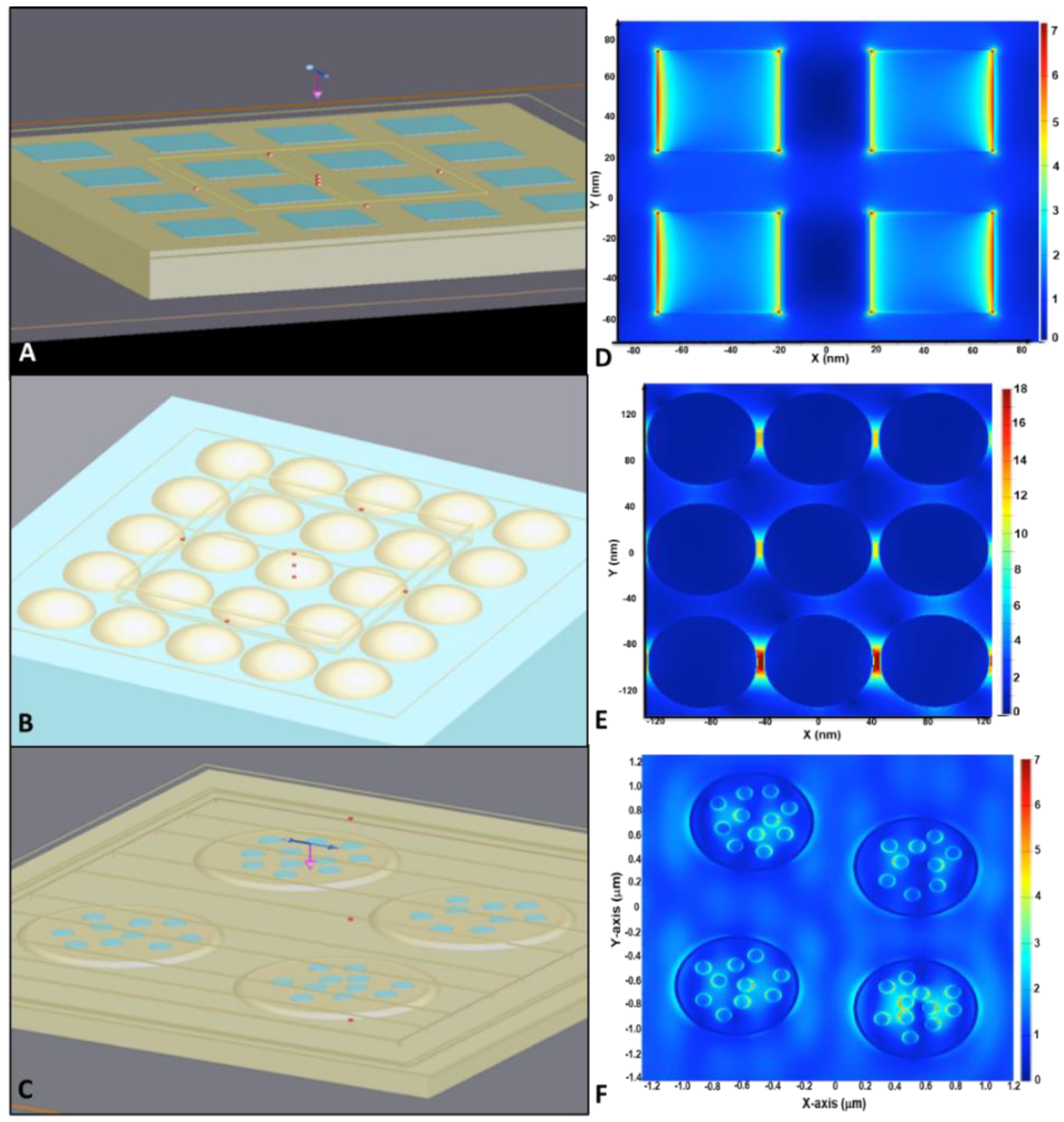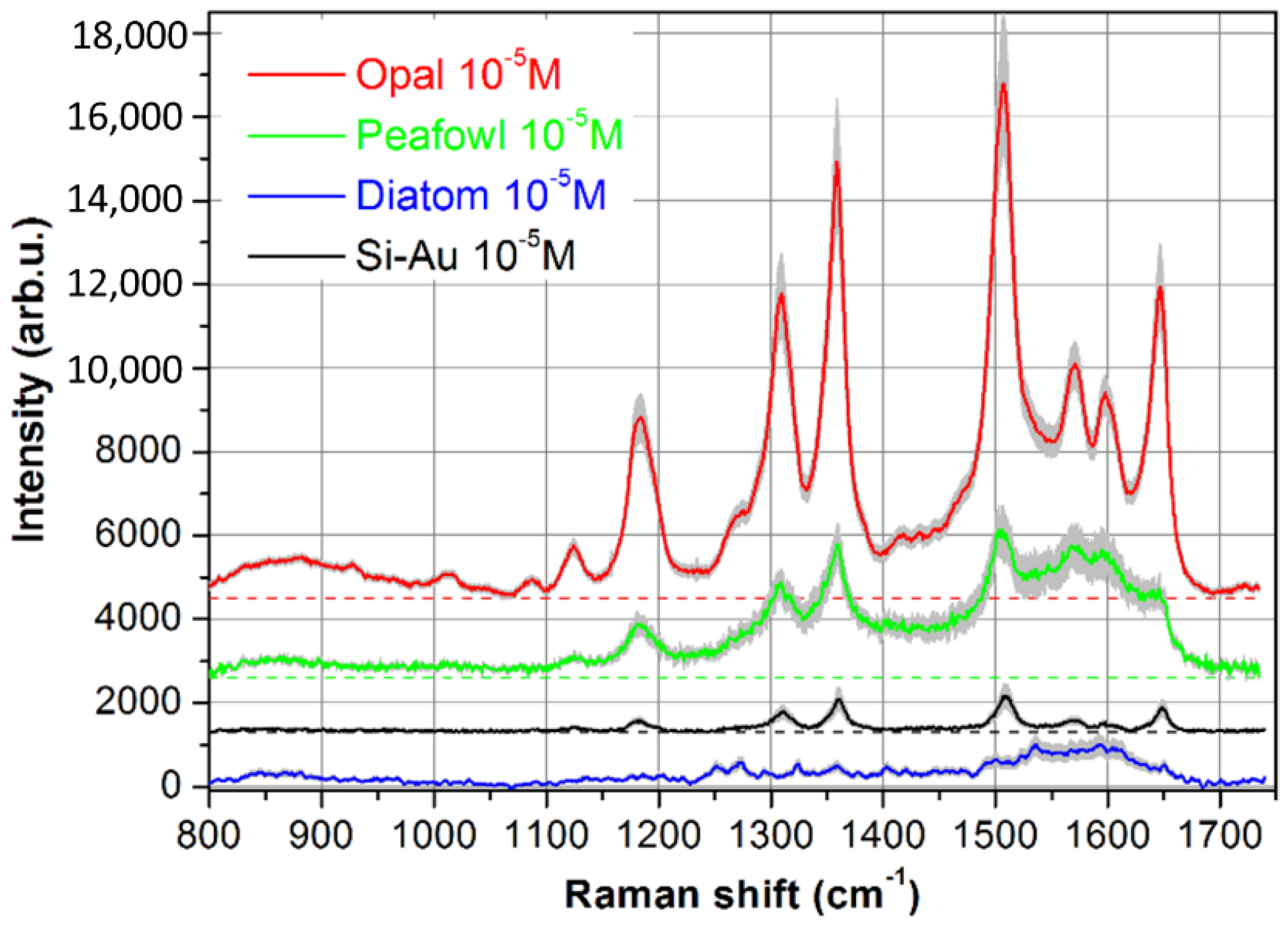Nature Inspired Plasmonic Structures: Influence of Structural Characteristics on Sensing Capability
Abstract
:Featured Application
Abstract
1. Introduction
2. Materials and Methods
2.1. Natural Nanophotonic Structures
2.1.1. Peacock Feather
2.1.2. Opal
2.1.3. Diatoms
2.2. Theoretical Simulations
2.3. SEM Characterization
2.4. Raman Spectroscopy Characterization of the Natural Plasmonic Nanostructures
3. Results and Discussion
3.1. Optical and SEM Images of the Characterized Samples
3.2. Simulated Enhanced Fields
3.3. Raman Analysis
4. Conclusions
Author Contributions
Acknowledgments
Conflicts of Interest
References
- DeVetter, B.M.; Mukherjee, P.; Murphy, C.J.; Bhargava, R. Measuring binding kinetics of aromatic thiolated molecules with nanoparticles via surface-enhanced Raman spectroscopy. Nanoscale 2015, 7, 8766–8775. [Google Scholar] [CrossRef] [PubMed]
- Geng, J.; Aioub, M.; El Sayed, M.A.; Barry, B.A. An Ultraviolet Resonance Raman Spectroscopic Study of Cisplatin and Transplatin Interactions with Genomic DNA. J. Phys. Chem. B 2017, 121, 8975–8983. [Google Scholar] [CrossRef] [PubMed]
- Vo-Dinh, T.; Fales, A.M.; Griffin, G.D.; Khoury, C.G.; Liu, Y.; Ngo, H.; Norton, S.J.; Register, J.K.; Wang, H.N.; Yuan, H. Plasmonic nanoprobes: From chemical sensing to medical diagnostics and therapy. Nanoscale 2013, 5, 10127–10140. [Google Scholar] [CrossRef] [PubMed]
- Zavaleta, C.L.; Kircher, M.F.; Gambhir, S.S. Raman’s “Effect” on Molecular Imaging. J. Nucl. Med. 2011, 52, 1839–1844. [Google Scholar] [CrossRef] [PubMed]
- Le Ru, E.; Etchegoin, P.G. Principles of Surface-Enhanced Raman Spectroscopy; Elsevier: New York, NY, USA, 2008; ISBN 978-0-444-52779-0. [Google Scholar]
- Kim, D.; Campos, A.R.; Datt, A.; Gao, Z.; Rycenga, M.; Burrows, N.D.; Greeneltch, N.G.; Murphy, C.A.M.C.J.; van Duyne, R.P.; Haynes, C.L. Microfluidic-SERS Devices for One Shot Limit-of-Detection. Analyst 2014, 139, 3227–3234. [Google Scholar] [CrossRef] [PubMed]
- Hamon, C.; Liz-Marzán, L.M. Colloidal Design of Plasmonic Sensors Based on Surface Enhanced Raman Scattering. J. Colloid Interface Sci. 2018, 512, 834–843. [Google Scholar] [CrossRef] [PubMed]
- Gentile, F.; Das, G.; Coluccio, M.L.; Mecarini, F.; Accardo, A.; Tirinato, L.; Tallerico, R.; Cojoc, G.; Liberale, C.; Candeloro, P.; et al. Ultra low concentrated molecular detection using super hydrophobic surface based biophotonic devices. Microelectron. Eng. 2010, 87, 798–801. [Google Scholar] [CrossRef]
- Das, G.; Coluccio, M.L.; Alrasheed, S.; Giugni, A.; Allione, M.; Torre, B.; Perozziello, G.; Candeloro, P.; Di Fabrizio, E. Plasmonic nanostructures for the ultrasensitive detection of biomolecules. Riv. Nuovo Cimento 2016, 39, 547–586. [Google Scholar]
- Perozziello, G.; Giugni, A.; Allione, M.; Torre, B.; Das, G.; Coluccio, M.L.; Marini, M.; Tirinato, L.; Moretti, M.; Limongi, T.; et al. Nanoplasmonic and microfluidic devices for biological sensing. In NATO Science for Peace and Security Series B: Physics and Biophysics; Springer: Berlin, Germany, 2017; pp. 247–274. [Google Scholar]
- Perozziello, G.; Candeloro, P.; de Grazia, A.; Esposito, F.; Allione, M.; Coluccio, M.L.; Tallerico, R.; Valpapuram, I.; Tirinato, L.; Das, G.; et al. Microfluidic device for continuous single cells analysis via Raman spectroscopy enhanced by integrated plasmonic nanodimers. Opt. Express 2016, 24, A180–A190. [Google Scholar] [CrossRef] [PubMed]
- Itoh, T.; Yamamoto, Y.S.; Ozaki, Y. Plasmon-enhanced spectroscopy of absorption and spontaneous emissions explained using cavity quantum optics. Chem. Soc. Rev. 2017, 46, 3904–3921. [Google Scholar] [CrossRef] [PubMed]
- Gao, Z.; Burrows, N.D.; Valley, N.A.; Schatz, G.C.; Murphy, C.J.; Haynes, C.L. In Solution SERS Sensing Using Mesoporous Silica-Coated Gold Nanorods. Analyst 2016, 141, 5088–5095. [Google Scholar] [CrossRef] [PubMed]
- Hooshmand, N.; Mousavi, H.S.; Panikkanvalappil, S.R.; Adibi, A.; El-Sayed, M.A. High-sensitivity molecular sensing using plasmonic nanocube chains in classical and quantum coupling regimes. Nano Today 2017, 17, 14–22. [Google Scholar] [CrossRef]
- Kanipe, K.N.; Chidester, P.P.F.; Stucky, G.D.; Meinhart, C.D.; Moskovits, M. Properly Structured, Any Metal Can Produce Intense Surface Enhanced Raman Spectra. J. Phys. Chem. C 2017, 121, 14269–14273. [Google Scholar] [CrossRef]
- Coluccio, M.L.; Gentile, F.; Das, G.; Nicastri, A.; Perri, A.M.; Candeloro, P.; Perozziello, G.; Proietti, R.; Totero-Gongora, J.S.; Alrasheed, S.; et al. Detection of single amino acid mutation from human breast cancer by plasmonic self-similar chain. Sci. Adv. 2015, 1, e1500487. [Google Scholar] [CrossRef] [PubMed]
- Perozziello, G.; Candeloro, P.; Gentile, F.; Nicastri, A.; Perri, A.M.; Coluccio, M.L.; Parrotta, E.; de Grazia, A.; Tallerico, M.; Pardeo, F.; et al. A microfluidic dialysis device for complex biological mixture SERS analysis. Microelectron. Eng. 2015, 144, 37–41. [Google Scholar] [CrossRef]
- Perozziello, G.; Candeloro, P.; Gentile, F.; Nicastri, A.; Perri, A.; Coluccio, M.L.; Adamo, A.; Pardeo, F.; Catalano, R.; Parrotta, E.; et al. Microfluidics & Nanotechnology: Towards fully integrated analytical devices for the detection of cancer biomarkers. RSC Adv. 2014, 4, 55590–55598. [Google Scholar]
- Coluccio, M.L.; Gentile, F.; Francardi, M.; Perozziello, G.; Malara, N.; Candeloro, P.; Di Fabrizio, E. Electroless Deposition and Nanolithography Can Control the Formation of Materials at the Nano-Scale for Plasmonic Applications. Sensors 2014, 14, 6056–6083. [Google Scholar] [CrossRef] [PubMed]
- Candeloro, P.; Iuele, E.; Perozziello, G.; Coluccio, M.L.; Gentile, F.; Malara, N.; Mollace, V.; Di Fabrizio, E. Plasmonic nanoholes as SERS devices for biosensing applications: An easy route for nanostructures fabrication on glass substrates. Microelectron. Eng. 2017, 175, 30–33. [Google Scholar] [CrossRef]
- Coluccio, M.L.; Francardi, M.; Gentile, F.; Candeloro, P.; Ferrara, L.; Perozziello, G.; Di Fabrizio, E. Plasmonic 3D-structures based on silver decorated nanotips for biological sensing. Opt. Lasers Eng. 2016, 76, 45–51. [Google Scholar] [CrossRef]
- Vinod, M.; Gopchandran, K.G. Au, Ag and Au:Ag colloidal nanoparticles synthesized by pulsed laser ablation as SERS substrates. Prog. Nat. Sci. Mater. Int. 2014, 24, 569–578. [Google Scholar] [CrossRef]
- Cyrankiewicz, M.; Wybranowski, T.; Kruszewski, S. Study of SERS efficiency of metallic colloidal systems. J. Phys. Conf. Ser. 2007, 79, 012013. [Google Scholar] [CrossRef]
- Kneipp, K.; Kneipp, H.; Manoharan, R.; Hanlon, E.B.; Itzkan, I.; Dasari, R.R.; Feld, M.S. Extremely Large Enhancement Factors in Surface-Enhanced Raman Scattering for Molecules on Colloidal Gold Clusters. Appl. Spectrosc. 1998, 52, 1493–1497. [Google Scholar] [CrossRef]
- Lee, C.; Robertson, C.S.; Nguyen, A.H.; Kahraman, M.; Wachsmann-Hogiu, S. Thickness of a metallic film, in addition to its roughness, plays a significant role in SERS activity. Sci Rep. 2015, 5, 11644. [Google Scholar] [CrossRef] [PubMed]
- Botta, R.; Rajanikanth, A.; Bansal, C. Silver nanocluster films for glucose sensing by Surface Enhanced Raman Scattering (SERS). Sens. Bio-Sens. Res. 2016, 9, 13–16. [Google Scholar] [CrossRef]
- Pisco, M.; Galeotti, F.; Quero, G.; Grisci, G.; Micco, A.; Mercaldo, L.V.; Veneri, P.D.; Cutolo, A.; Cusano, A. Nanosphere lithography for optical fiber tip nanoprobes. Light Sci. Appl. 2017, 6, e16229. [Google Scholar] [CrossRef]
- Garoff, S.; Weitz, D.A.; Alvarez, M.S.; Chung, J.C. Electromagnetically Induced Changes in Intensities, Spectra and Temporal Behavior of Light Scattering from Molecules on Silver Island Films. J. Phys. Colloq. 1983, 44, C10-345–C10-348. [Google Scholar] [CrossRef]
- Edel, J.B.; Kornyshev, A.A.; Urbakh, M. Self-Assembly of Nanoparticle Arrays for Use as Mirrors, Sensors and Antennas. ACS Nano 2013, 7, 9526–9532. [Google Scholar] [CrossRef] [PubMed]
- Zhang, X.; Young, M.A.; Lyandres, O.; van Duyne, R.P. Rapid detection of an anthrax biomarker by surface-enhanced Raman spectroscopy. J. Am. Chem. Soc. 2005, 127, 4484–4489. [Google Scholar] [CrossRef] [PubMed]
- Cho, H.; Kumar, S.; Yang, D.; Vaidyanathan, S.R.; Woo, K.; Garcia, I.; Shue, H.J.; Yoon, Y.; Ferreri, K.; Choo, H. SERS-Based Label-Free Insulin Detection at Physiological Concentrations for Analysis of Islet Performance. ACS Sens. 2018, 3, 65–71. [Google Scholar] [CrossRef] [PubMed]
- Ngo, H.T.; Wang, H.; Burke, T.; Ginsburg, G.S.; Vo-Dinh, T. Multiplex detection of disease biomarkers using SERS molecular sentinel-on-chip. Anal. Bioanal. Chem. 2014, 406, 3335–3344. [Google Scholar] [CrossRef] [PubMed]
- Ngo, H.T.; Wang, H.; Fales, A.M.; Vo-Dinh, T. Plasmonic SERS biosensing nanochips for DNA detection. Anal. Bioanal. Chem. 2016, 408, 1773–1781. [Google Scholar] [CrossRef] [PubMed]
- Kanipe, K.N.; Chidester, P.P.F.; Stucky, G.D.; Moskovits, M. Large Format Surface-Enhanced Raman Spectroscopy Substrate Optimized for Enhancement and Uniformity. ACS Nano 2016, 10, 7566–7571. [Google Scholar] [CrossRef] [PubMed]
- Srinivasarao, M. Nano-Optics in the biological World: Beetles, Butterflies, Birds, and Moths. Chem. Rev. 1999, 99, 1935–1961. [Google Scholar] [CrossRef] [PubMed]
- Wu, L.Y.; Ross, B.M.; Hong, S.; Lee, L.P. Bioinspired nanocorals with decoupled cellular targeting and sensing functionality. Small 2010, 6, 503–507. [Google Scholar] [CrossRef] [PubMed]
- Zhang, Q.X.; Chen, Y.X.; Guo, Z.; Liu, H.L.; Wang, D.P.; Huang, X.J. Bioinspired multifunctional hetero-hierarchical micro/nanostructure tetragonal array with self-cleaning, anticorrosion, and concentrators for the SERS detection. ACS Appl. Mater. Interfaces 2013, 5, 10633–10642. [Google Scholar] [CrossRef] [PubMed]
- Ren, F.; Campbell, J.; Hasan, D.; Wang, X.; Rorrer, G.L.; Wang, A.X. Bio-inspired plasmonic sensors by diatom frustules. In Proceedings of the Lasers and Electro-Optics (CLEO), San Jose, CA, USA, 9–14 June 2013; IEEE: Piscataway, NJ, USA, 2013; pp. 1–2. [Google Scholar]
- Hong, S.; Lee, M.Y.; Jackson, A.O.; Lee, P.L. Bioinspired optical antennas: Gold plant viruses. Light Sci. Appl. 2015, 4, e267. [Google Scholar] [CrossRef]
- Gentile, F.; Coluccio, M.L.; Accardo, A.; Marinaro, G.; Rondanina, E.; Santoriello, S.; Marra, S.; Das, G.; Tirinato, L.; Perozziello, G.; et al. Tailored Ag nanoparticles/nanoporous superhydrophobic surfaces hybrid devices for the detection of single molecule. Microelectron. Eng. 2012, 97, 349–352. [Google Scholar] [CrossRef]
- Li, W.; Camargo, P.H.C.; Lu, X.; Xia, Y. Dimers of Silver Nanospheres: Facile Synthesis and Their Use as Hot Spots for Surface-Enhanced Raman Scattering. Nano Lett. 2009, 9, 485–490. [Google Scholar] [CrossRef] [PubMed]
- Velleman, L.; Scarabelli, L.; Sikdar, D.; Kornyshev, A.A.; Liz-Marzán, L.M.; Edel, J.B. Monitoring Plasmon Coupling and SERS Enhancement Through in situ Nanoparticle Spacing Modulation. Faraday Discuss 2017, 205, 67–83. [Google Scholar] [CrossRef] [PubMed]
- Geldmeier, J.A.; Mahmoud, M.A.; Jeon, J.W.; El-Sayed, M.; Tsukruk, V.V. The effect of plasmon resonance coupling in P3HT-coated silver nanodisk monolayers on their optical sensitivity. J. Mater. Chem. C 2016, 4, 9813–9822. [Google Scholar] [CrossRef]
- Bosnick, K.A.; Wang, H.M.; Haslett, T.L.; Moskovits, M. Quantitative Determination of the Raman Enhancement of Ag30(CO)25 and Ag50(CO)40 Matrix Isolated in Solid Carbon Monoxide. J. Mater. Chem. C 2016, 120, 20506–20511. [Google Scholar] [CrossRef]
- Han, J.; Su, H.; Song, F.; Gu, J.; Zhang, D.; Jiang, L. Novel Photonic Crystals: Incorporation of Nano-CdS into the Natural Photonic Crystals within Peacock Feathers. Langmuir 2009, 25, 3207–3211. [Google Scholar] [CrossRef] [PubMed]
- De Tommasi, E.; Rea, I.; Mocella, V.; Moretti, L.; De Stefano, M.; Rendina, I.; De Stefano, L. Multi-wavelength study of light transmitted through a single marine centric diatom. Opt. Express 2010, 18, 12203–112212. [Google Scholar] [CrossRef] [PubMed]
- De Stefano, M.; De Stefano, L. Nanostructures in diatom frustules: Functional morphology of valvocopulae in cocconeidacean monoraphid Taxa. J. Nanosci. Nanotechnol. 2005, 5, 1–10. [Google Scholar] [CrossRef]
- Yu, R.; Liz-Marzán, L.M.; García de Abajo, F.J. Universal Analytical Modeling of Plasmonic Nanoparticles. Chem. Soc. Rev. 2017, 46, 6710–6724. [Google Scholar] [CrossRef] [PubMed]
- Johnson, P.B.; Christy, R.W. Optical Constants of the Noble Metals. Phys. Rev. B 1972, 6, 4370. [Google Scholar] [CrossRef]
- Sil, S.; Kuhar, N.; Acharya, S.; Umapathy, S. Is Chemically Synthesized Graphene‘Really’ a Unique Substrate for SERS and Fluorescence Quenching? Sci. Rep. 2013, 3, 3336. [Google Scholar] [CrossRef] [PubMed]
- Yoshida, K.; Itoh, T.; Tamaru, H.; Biju, V.; Ishikawa, M.; Ozaki, Y. Quantitative evaluation of electromagnetic enhancement in surface-enhanced resonance Raman scattering from plasmonic properties and morphologies of individual Ag nanostructures. Phys. Rev. B 2010, 81, 115406. [Google Scholar] [CrossRef]




© 2018 by the authors. Licensee MDPI, Basel, Switzerland. This article is an open access article distributed under the terms and conditions of the Creative Commons Attribution (CC BY) license (http://creativecommons.org/licenses/by/4.0/).
Share and Cite
Perozziello, G.; Candeloro, P.; Coluccio, M.L.; Das, G.; Rocca, L.; Pullano, S.A.; Fiorillo, A.S.; De Stefano, M.; Di Fabrizio, E. Nature Inspired Plasmonic Structures: Influence of Structural Characteristics on Sensing Capability. Appl. Sci. 2018, 8, 668. https://doi.org/10.3390/app8050668
Perozziello G, Candeloro P, Coluccio ML, Das G, Rocca L, Pullano SA, Fiorillo AS, De Stefano M, Di Fabrizio E. Nature Inspired Plasmonic Structures: Influence of Structural Characteristics on Sensing Capability. Applied Sciences. 2018; 8(5):668. https://doi.org/10.3390/app8050668
Chicago/Turabian StylePerozziello, Gerardo, Patrizio Candeloro, Maria Laura Coluccio, Godind Das, Loredana Rocca, Salvatore Andrea Pullano, Antonino Secondo Fiorillo, Mario De Stefano, and Enzo Di Fabrizio. 2018. "Nature Inspired Plasmonic Structures: Influence of Structural Characteristics on Sensing Capability" Applied Sciences 8, no. 5: 668. https://doi.org/10.3390/app8050668
APA StylePerozziello, G., Candeloro, P., Coluccio, M. L., Das, G., Rocca, L., Pullano, S. A., Fiorillo, A. S., De Stefano, M., & Di Fabrizio, E. (2018). Nature Inspired Plasmonic Structures: Influence of Structural Characteristics on Sensing Capability. Applied Sciences, 8(5), 668. https://doi.org/10.3390/app8050668








